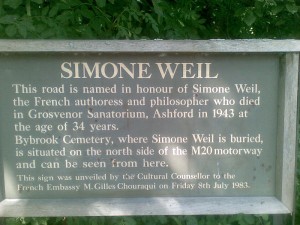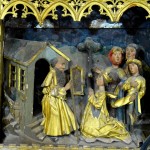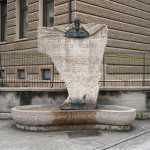
“Simone Weil A28 Plaque” – FeydHuxtable – CC0 1.0 Universal Public Domain Dedication
I chose the name of the blog based on the experiences of Simone Weil, a spiritual teacher and personal hero of mine. Most of you who read this channel are probably already familiar with Weil, the French philosopher-mystic who composed some of the most penetrating work on the nature of violence ever written. If not, The Need For Roots and The Iliad or The Poem of Force are must-reads.
Weil frequently discussed Catholicism in her correspondence with J.M. Perrin, a Dominican priest, but Weil always maintained that her proper place was right outside the threshold of the Church. She wrote to Perrin:
I cannot help wondering whether in these days when so large a proportion of humanity is submerged in materialism, God does not want there to be some men and women who have given themselves to him and to Christ and who yet remain outside the church.
Weil’s conception of Christianity was severe, almost gnostic. She had a profound disdain for human flesh, and in fact she starved herself to death in England during the Second World War in a bid to show solidarity with her countrymen living under Nazi rule. She was a Platonist, holding her nose at Aristotle. And though I don’t have any evidence on hand, I’m absolutely sure that she would have been temperamentally uncomfortable with The Incarnation itself.
Nevertheless, she was brilliant, profound, and shaken to her core with a deep sympathy for suffering people. The Rev. Terry Tastard wrote, “In an age when the language of human development and spiritual enrichment is often found in the churches, Simone Weil sounds a discordant note. She is quite blunt about the fact that compassion requires attention, and attention will be a kind of diminishment. Yet there is something refreshing about her astringency, and her decision to remain on the threshold of the church is intriguing. After all, there is a long Jewish and Christian tradition of prophets choosing to live on the margin of society. Thomas Merton wrote inConjectures of a Guilty Bystander that Simone Weil and Charles Péguy preferred not to be in the middle of the Catholically approved and well-censored page, but only on the margin. And they remained there as question marks: questioning not Christ, but Christians.”
A much as I admire Weil’s position intellectually, it still breaks my heart that she never took those steps and moved inside the Church. I guess it’s safe to say that this blog is named in a kind of romantic tribute to everything that Weil taught me – and the line beyond which she herself sadly decided not to cross.












